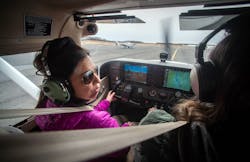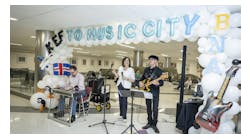Hartford-Brainard Airport Flight School Sees Airfield Taking Off in Futuristic World of Air Travel
Flight school owner Phil Smith says he doesn’t need another expensive study to know the options for the future of Hartford-Brainard Airport.
Smith, co-founder of Learn 2 Fly CT, said he already can see it with increased registration at his school — just three years after establishing it at Brainard — and in the rapidly evolving, electric-powered aircraft industry that would make Brainard, Smith believes, indispensable for training and as a hub for the new technology.
“We’re smack dab in the middle of two giant municipalities — Boston and New York City — and it’s a perfect location for it,” Smith said. “Weather-wise, we get all four seasons — some times the extremes of the seasons — so we’re perfectly suited for this new technology that is coming that is going to revolutionize transportation in the world.”
Smith envisions a future with air taxis and what he calls consumer-owned “Jetson cars” — after those portrayed in the iconic, futuristic cartoon “The Jetsons” that first aired in the 1960s — and which operate similar to a drone. The new technology is at least five years away, but prototypes are being developed in this country and abroad.
Smith said Brainard could become a hub for the new, quieter technology and his flight school and two others at Brainard could evolve to also provided the pilot training that would be required by the Federal Aviation Administration.
Smith is on one side of a debate about what to do with the 200-acre airport in Hartford’s South Meadows. The debate goes back decades to at least the late 1950s when the airport was reduced in size for redevelopment and what remained was sold to the state.
Two studies, one in 1990 and another in 2016, recommended keeping the airfield open and building it up as an economic driver and amenity for the region.
Now, a controversial, $1.5 million study, due in October, that is expected to outline options for the century-old airport — visited by aviation legends Charles Lindbergh and Amelia Earhart — both for redevelopment, including more public access, and keeping the airport open.
Questions surrounding Brainard’s future again surfaced in recent years as Hartford Mayor Luke Bronin and Sen. John Fonfara, a Hartford Democrat, pushed for redevelopment that would help build the city tax base and make better use of the property on the Connecticut River. Fonfara is now a candidate for mayor.
Even if the state legislature were to recommend closing the airport in favor of redevelopment, the FAA would still have to approve it.
Opposition to closing has been so strong, however, that the Hartford Brainard Airport Association was formed to fight efforts to redevelop. Opponents see not only potential for further development, but sky-high costs to clean-up suspected soil contamination lurking under the airport.
Smith said he believes so deeply in the future of Brainard that he became part-owner of a two-seater, electric-powered Pipistrel Alpha Electro airplane now parked in a Brainard hangar “to show politicians and the public the potential for this property.”
‘If you don’t do it now’
On a recent chilly morning , Smith stands on the tarmac at Brainard and recounts how he and his wife founded Learn 2 Fly CT in 2018 with one plane at Windham Airport and Smith the sole instructor.
Five years later, Smith has 13 single- and twin-engine airplanes and 15 flight instructors at three airports, Brainard now the largest with 100 of roughly 120 students, split between those intent on piloting as a career and those that want to pursue it recreationally.
Nearby, Sophie Belanger, who lives in Suffield, readies for a lesson on taxiing. Flights aren’t permitted this morning because of on-going tree-trimming at the airport.
Canadian-born Belanger said she has wanted to fly since she was a teenager, just for the “freedom.”
“Initially, you’re too young, and then you get young kids and then, at some point, you’re 40, and then, you’re like, if you don’t do it now, you’ll never do it,” said Belanger, a part-time neonatal nurse at Connecticut Children’s in Hartford. “So I jumped in this year.”
Belanger said she and her husband would like to own their own aircraft in the next few years, flying to Cape Cod and elsewhere. Eventually, Belanger said she’d like to have enough training to one day fly to her native Quebec.
The prospect of Brainard closing would eliminate an accessible sized-airport for beginners and all it has to offer, including the control tower, that isn’t part of all smaller airports, Belanger said. Learning to interact with the control tower is essential to more sophisticated flight training.
“It’s kind of a medium-size airport versus a small, small airport or the big, big airport like Bradley,” Belanger said. “You don’t learn to fly at Bradley.”
Broader aviation ecosystem
Belanger’s flight instructor Arianna Strand is taking another route in aviation, hoping to land a job as a commercial pilot with a major airline. At 22, Strand already has a degree in professional pilot technology and she sees potential not only for the flight schools at Brainard but for a broader aviation ecosystem that already includes mechanic training and avionics.
“There is just so much going on at this airport,” Strand said, pointing out different parts of Brainard. “There are three flight schools. There’s the maintenance school. On top of all of that, this row is all people who base their planes here. Say this airport shuts down. Where is everyone going to go? It would hurt a lot.”
Opponents of closing Brainard push back on the notion that the airport is “a playground for rich folks” with single- and twin-engine planes.
The Hartford chapter of the Experimental Aircraft Association is building an airplane in a hangar at Brainard assisted by students interested in aviation. Since 1992, chapter members have has taken more than 1,000 children between the ages of 8 and 17 for rides in small aircraft in the national “Young Eagles” program, some of them going on to become pilots.
“We play a small part in there building the airplane with the student members that come in and the Young Eagles,” Steve Socolosky, president of the Hartford chapter, said. “But there are three flight schools there, too, and with the pilot shortage, how do you discount making flight schools go away? And Brainard is such a prime place for flight training because it has a control tower.”
Mickey Perez, president of the Connecticut chapter of Women in Aviation International, said a closure of Brainard would impact programs she runs. Those include include visits to the airport for girls and boys designed to spark an interest in aviation and aerospace careers but also broader jobs in manufacturing and related STEM — Science, Technology, Engineering and Math — jobs, Perez said.
Experts say the 100,000 job openings in Connecticut are heavily concentrated in the manufacturing sector.
Last year, 200 students and their families visited Brainard, seeing everything from airplanes being worked on in a hangar to a security-cleared visit to the control tower.
“Understanding and tying that into engineering, whether it’s civil engineering or manufacturing engineering, it’s very easy to tie in all of these different STEM-related industries into an airport,” Perez said. “It’s got a little bit of everything.”
Kenneth R. Gosselin can be reached at [email protected].
©2023 Hartford Courant. Visit courant.com. Distributed by Tribune Content Agency, LLC.



